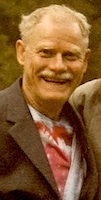
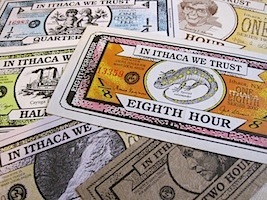
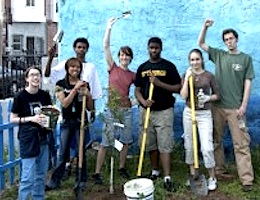
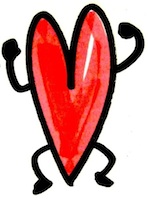
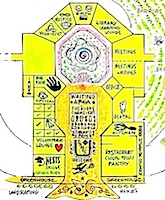
 |
 |
 |
 |
 |
| PAUL GLOVER ESSAYS: community
control of food, fuel, housing, health care,
planning, education, finance. |
| HOME | INTRO | CURRENCY | SUCCESSES | HOW-TO BOOK | PUBLICITY | ESSAYS |
|
A History
of Ithaca HOURS
January
2000
HOURS were created by our community's need and pioneer spirit. During the 1991 recession I designed prototype HOURS and began asking people to sign up to accept them. The first 30 people agreed. Had these folks said "that's a dumb idea" or "you could get in trouble," or had they just laughed, then maybe there'd be no HOUR money. Had there been no Farmer's Market here, with lively vendors who saw HOURS as yet another way to barter, HOURS would have had a small food base. Catherine Martinez took the first leap of faith there, becoming the first person to accept an HOUR, for her samosa. Had the owners of two popular local movie theaters (Rich Szany & Lynn Cohen) not started taking HOURS from the beginning, at full price, then there's have been no dramatic retail use of HOURS. Had Greg Spence Wolf not stepped in to earn HOURS cleaning these theaters, then maybe the theaters would have stopped accepting HOURS. Had the Alternatives Federal Credit Union not lent its fiscal credibility to HOURS, by accepting them for fees, acceptance of HOURS would have been slower. Michael Turback of Turback's restaurant (the fanciest in town) accepted HOURS for full price. James Cummins of Littletree Orchards did likewise. These and dozens of other pioneers pulled lots of HOURS into circulation and spread them around. Thousands more Ithacans have established HOURS by accepting them and spending them, and by explaining them to family and friends. Tens of thousands of conversations have defined local money and have carried it forward. History is made by public action like this, rather than by special leaders. The general public selects and rejects leaders daily, before knowing their names, without waiting to vote. History pushes individuals forward to meet human needs. That's why credit for HOURS belongs to the community. Thus my own role, regarded as pivotal, merely was the tool of the community's need. To emphasize this, I've declined to be interviewed on TV and most radio, in order to require media to showcase HOURS as a community process. During research into our local economy in 1989, I noticed that a little county in South Dakota printed coupons for downtown merchant X-mas promotion, the first I had ever heard of local currency. Two years later, early in 1991, while drawing pictures with my girlfriend's nieces, I sketched a cartoon "Ithaca Money" note. A few weeks later I saw a sample "Hour" note issued by British industrialist Robert Owen in 1847. This Hour was negotiable only at Owens' company store and based, I discovered in 1993, on Josiah Warren's "Time Store" notes of 1827. During May 1991, local student Patrice Jennings asked to interview me about the Ithaca LETS system. This conversation strongly reinforced my interest in barter, and Patrice suggested we revive a grassroots trading system. Local merchant Tom Koslowski encouraged the idea of local currency when it was mentioned to him. A few days later, Annie McCasland, my landlady's daughter, entered my room saying she had just heard an NPR report about Deli Dollars, organized by the E.F. Schumacher Society of Great Barrington, Massachusetts. Within a few days designs for the HOUR and Half HOUR were complete except for signatures. Patrice and I began to encourage participation. Approached at GreenStar Co-op with photocopied samples and a signup sheet on clipboard, Gary Fine, a local massage therapist, said "sure," and signed. Then came Jan Nigro, songwriter/musician; Mary Loehr, writer and cook. The first dozens all agreed, without waiting for a business plan or guarantee. Emboldened, I began to ask for small donations to help pay for printing HOURS. During the next four months, 90 people provided 262 offers (++) and requests (--) for the first issue of Ithaca Money. Jim Rohrrsen of Papa Jim's toys became the first retailer to actually enroll to accept HOURS. Fine Line Printing completed the first run of HOURS October 1991. These notes, 1,500 HOURS and 1,500 Half HOURS, were nearly twice as large as subsequent notes. Ithaca Money #1 (now HOUR Town) was printed at Our Press in Chenango Bridge, NY on October 16, 1991. The next day I issued myself 10 HOURS as the first of four repayments for the cost of printing HOURS (David St. George of Fine Line accepted 10% of his payment in HOURS). The day after that, October 18, 1991, 382 HOURS were disbursed and prepared for mailing to the first 93 pioneers. That same day, on October 19, I bought a samoza at the Farmer's Market with Half HOUR #751 from from Catherine Martinez-- the first use of an HOUR. Neither of us knew what a Half HOUR was worth, since the $10/HOUR rate was then merely suggested. Several more Market vendors enrolled. |
Only
46 days after HOURS began, and only ten days after the Farmer's
Market closed for the season, GreenStar Co-op burned down. Local food
vendors selling through GreenStar quickly organized a Mini-Market at
Henry St. Johns school, and most of them decided to accept HOURS. This
provided HOURS with a midwinter food base right from the beginning. Confusion arose about varied HOUR equivalencies ($5, $6, $8, $10, $12) and soon caused us to declare $10.00 as the standard. And it soon became apparent that a smaller denomination, and smaller note size, were needed. The Quarter HOUR was issued six months after we began. Stacks of Ithaca Money were distributed all over town with an invitation to everyone to join the fun. The Ithaca Journal (John Yaukey) did a fine introductory article. Radio WHCU (Casey Stevens) followed with a short interview about HOURS, the Syracuse Post-Standard, The Grapevine, the Cornell Sun. The Ithaca Times article was surprisingly hostile and was easily rebutted by a letter (11/21/91). Patrice Jennings, founding member of the HOUR Board, was featured in a TV show by WICB and on other media. Signup coupons poured in (the first from fiddler Laurie Hart). Alternatives Federal Credit Union, Cinemapolis, Fall Creek Pictures, Toko Imports amd Papa Jim's toys were the first retailers. Meanwhile, HOURS were being traded and discussed, and welcomed and ridiculed. A common jibe was, "printing your own money are you? Pretty good business-- you must have a fat wallet!" So I showed them the disbursement sheets and explained serial numbers. Those who praised HOURS were thanked and invited to join us; those who criticized HOURS or found them threatening were invited, without resentment, to join if they came to feel differently, and many did so. By January of 1993 I was sending an occasional "Hometown Money Starter Kit" to people elsewhere who had heard about HOURS and wanted to try it in their community. The president of AFCU, Bill Myers, approached me in July 1993 and offered me one of the credit union's two VISTA (Americorps) positions. Thus, ironically, the federal government provided me a regular paycheck to develop local currency. This freed me to work without worrying about income,and it provided operating expenses. VISTA liked HOURS so much they employed me more than three years. When HOURS were featured on the cover of the Mother Earth News, showing printer David St. George at his press, one of that article's readers wrote to refer us to Professor Robert Blain of Southern Indiana University at Edwardsville, who he said had also promoted HOURS as money. When I wrote to Blain, he sent back copies of his 1979 monograph "Making Money a More Reliable Meaasure of Value." Remarkably, he had also suggested that HOURS become the new standard of value and had recommended a $10.00 equivalency. He started sending us stacks of his booklet, which had been collecting dust, and they were sent out with requests for Kits. With wider publicity, demand for Starter Kits expanded, becoming an important part of income. The Kit changed constantly, since the system was still being invented. Only by August 1995 had basic systems stabilized enough for the Kit to be published as a book. National publicity, which had begun in 1993, peaked in 1996, with stories in the New York Times, Wall Street Journal, Good Morning America, and many others. There have been over 650 stories written and broadcast about HOURS so far (see "Publicity"). The HOUR Advisory Board incorporated as Ithaca HOURS, Inc. in 1998, and hosted the first elections for Board of Directors. Monica Hargraves, director of composting for Co-op Extension (and a former economics professor and economist with the Federal Reserve and IMF), was selected as Board chair. Margaret McCasland (an educator in whose house HOURS were born) was selected as Board secretary, and has published HOUR Town since August 1999. The directory is now occasional rather than hexannual. Dan Cogan, a computer programmer, was selected as first Treasurer. Greg Spence Wolf, a singer-songwriter, and Bob LeRoy, an accountant, became co-vicepresidents. Others on the first elected Board were LeGrace Benson (former County representative and art historian), Jennifer Elges (veterinary student), Donald Stephenson (environmentalist), and Wally Woods (personnel manager). The board hosted a large and successful Community Celebration in November 1999, and annual meetings since. Steve Burke stepped in to serve as HOURS President for the next ten years, from 2001-2011. Paul Strebel took over in 2011. Most of the history of HOURS is to be told by the thousands here who have discussed them and earned them and spent them. They have made HOURS real money. See Success Stories on this site. |